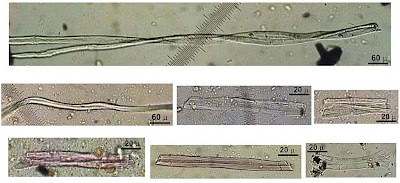 Un equipo de arqueólogos y paleobiólogos ha descubierto fibras de lino de más de 34.000 años de antigüedad, lo que las convierte en las fibras conocidas más antiguas utilizadas por los humanos. Las fibras, han descubiertas en una cueva de la República de Georgia durante excavaciones sistemáticas.
Un equipo de arqueólogos y paleobiólogos ha descubierto fibras de lino de más de 34.000 años de antigüedad, lo que las convierte en las fibras conocidas más antiguas utilizadas por los humanos. Las fibras, han descubiertas en una cueva de la República de Georgia durante excavaciones sistemáticas.El lino, que sería salvaje y no cultivado, podría haber sido utilizado para hacer hilo y tejidos utilizados para calentarse, coser piezas de cuero, hacer vestidos o atar mochilas que ayudarían a nuestros antepasados a moverse de un campamento a otro.
Según Bar-Yosef de la Universidad de Harvard "Este fue un invento crítico para los humanos. Podrían haber utilizado esta fibra para hacer vestidos, cuerdas o cestos, utensilios empleados sobre todo en tareas domésticas". "Sabemos que se trata de lino salvaje que crecía en la vecindad de la cueva y que fue explotado intensa o extensivamente por los humanos modernos"
Bar-Yosef y su equipo utilizaron radiocarbono para datar los estratos de la cueva, lo que reveló la edad de las arcillas en las que se hallaron las fibras, que proceden de entre 21.0000 y 13.000 años atrás.
 A team of archaeologists and paleobiologists has discovered flax fibers that are more than 34,000 years old, making them the oldest fibers known to have been used by humans. The fibers, discovered during systematic excavations in a cave in the Republic of Georgia.
A team of archaeologists and paleobiologists has discovered flax fibers that are more than 34,000 years old, making them the oldest fibers known to have been used by humans. The fibers, discovered during systematic excavations in a cave in the Republic of Georgia.The flax, which would have been collected from the wild and not farmed, could have been used to make linen and thread, the researchers say. The cloth and thread would then have been used to fashion garments for warmth, sew leather pieces, make cloths, or tie together packs that might have aided the mobility of our ancient ancestors from one camp to another.
"This was a critical invention for early humans. They might have used this fiber to create parts of clothing, ropes, or baskets—for items that were mainly used for domestic activities," says Bar-Yosef of the Harvard University. "We know that this is wild flax that grew in the vicinity of the cave and was exploited intensively or extensively by modern humans."
Bar-Yosef and his team used radiocarbon dating to date the layers of the cave as they dug the site, revealing the age of the clay samples in which the fibers were found. Flax fibers were also found in the layers that dated to about 21,000 and 13,000 years ago.
Tomado de/Taken from Harvard University
Resumen de la publicación científica/Abstract of the paper
30,000-Year-Old Wild Flax Fibers
Eliso Kvavadze, Ofer Bar-Yosef, Anna Belfer-Cohen, Elisabetta Boaretto, Nino Jakeli, Zinovi Matskevich, Tengiz Meshveliani5
Science 11 September 2009:
Vol. 325. no. 5946, p. 1359
DOI: 10.1126/science.1175404
Abstract
A unique finding of wild flax fibers from a series of Upper Paleolithic layers at Dzudzuana Cave, located in the foothills of the Caucasus, Georgia, indicates that prehistoric hunter-gatherers were making cords for hafting stone tools, weaving baskets, or sewing garments. Radiocarbon dates demonstrate that the cave was inhabited intermittently during several periods dated to 32 to 26 thousand years before the present (kyr B.P.), 23 to 19 kyr B.P., and 13 to 11 kyr B.P. Spun, dyed, and knotted flax fibers are common. Apparently, climatic fluctuations recorded in the cave’s deposits did not affect the growth of the plants because a certain level of humidity was sustained.